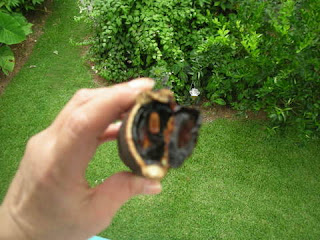 El Jefe found this woody 2-foot long "bean" which he said is called carao (pronounced ca-rah-oh). He said when he was little, they used to suck the jam-like fruit from the little sections containing seeds. The bean comes from a large pink-flowering tree called Cassia grandis. The tree is common from southern Mexico to northern South America.
El Jefe found this woody 2-foot long "bean" which he said is called carao (pronounced ca-rah-oh). He said when he was little, they used to suck the jam-like fruit from the little sections containing seeds. The bean comes from a large pink-flowering tree called Cassia grandis. The tree is common from southern Mexico to northern South America."It smells a little funny," he said, so I took a whiff. Yeah, "funny" like sweaty sneakers smell funny. However, I have heard of other tropical fruits, like the durian, which are said to smell absolutely terrible but taste wonderful. That is hard for me to imagine, but I was game so I tasted the goo around the seeds.
I tried really hard to think about how I could describe the flavor and I just don't know. I could almost fool myself into thinking there was a chocolate flavor, but mixed with something a bit tangy, maybe like chocolate and cherries mashed together.
 Apparently carao is most popularly used in a drink made with milk. I found a nice story about a small businesswoman who bottles the syrup in Costa Rica, amusingly titled "Don't let the smell fool you". Yes, I could see that diluted with milk it would probably taste pretty good. I'd have to use the machete to get all those little sections open and I don't think my aim is good enough for that.
Apparently carao is most popularly used in a drink made with milk. I found a nice story about a small businesswoman who bottles the syrup in Costa Rica, amusingly titled "Don't let the smell fool you". Yes, I could see that diluted with milk it would probably taste pretty good. I'd have to use the machete to get all those little sections open and I don't think my aim is good enough for that.This particular bean may be past its prime. Trying to get a better photo of the inside, I broke a piece off, but that end was white and dry inside. I couldn't break the remaining piece at all until I put one end on the floor and put my foot on it to break it, it was that hard!
 But then I somehow managed to take 4 blurry photos so you can't really see the inside anyway. Above you can see the brown goo on my finger. In the photo at the left, I have folded back one woody section to expose another seed and more gooey fruit. For a better look at the inside, see these photos.
But then I somehow managed to take 4 blurry photos so you can't really see the inside anyway. Above you can see the brown goo on my finger. In the photo at the left, I have folded back one woody section to expose another seed and more gooey fruit. For a better look at the inside, see these photos.I couldn't find much information on the internet and almost all of it is in Spanish. Apparently, it is known as a blood builder and is used to treat anemia. I wonder if this could be useful for treating dengue hemorrágico patients. Other (unproven) health claims are that it increases energy, increases milk in nursing mothers, prevents hemorrhages, and is an aphrodisiac.



 Welcome to my Blogicito —
Welcome to my Blogicito — 





